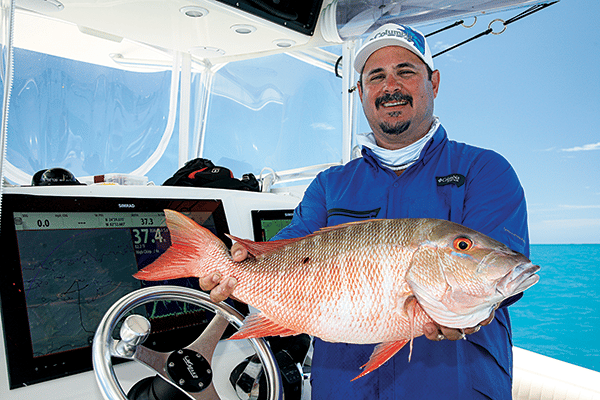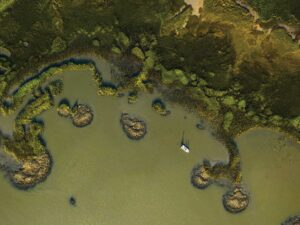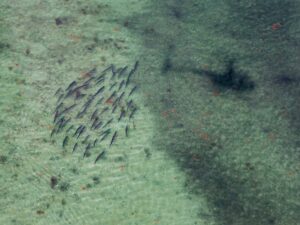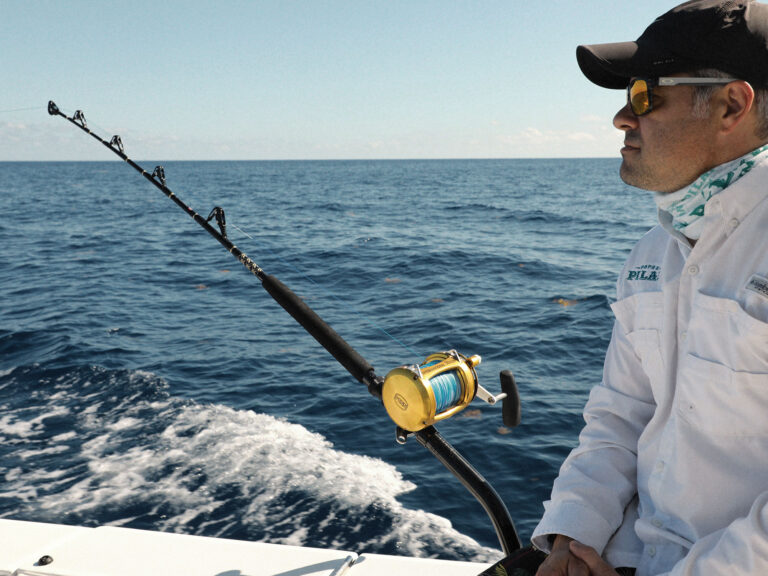
As the plane banked out over the Atlantic for the approach to Key West, my view of the flat ocean below revealed miles of sargassum stretched along the reef line, and hundreds of acres of the same blanketing huge stretches of water. Conditions looked perfect for offshore fishing. That much weed fosters a food chain beneath, promising plenty of baitfish and predators drawn to them.
Over a few days in June, we convened as guests of Columbia Sportswear: a couple of dozen anglers — from seasoned saltwater devotees to dedicated fly-fishers, and most interesting, a number of anglers with proven freshwater chops who were about to get a baptism in the salt.
The diverse group of anglers, pretty good weather, excellent guides, and the variety of fish typical of the place combined to provide a textbook look at just how much Key West has to offer newcomers and veterans alike.

Into the Blue
The first morning, five of us boarded George Poveromo’s Marc VI and headed for the Gulf Stream. The acres of weeds that covered the ocean the afternoon before seemed to have melted away, broken up by the wind that kicked up in the night, so Poveromo aimed for the horizon, hunting for any signs of life.
Beyond 1,000 feet of water, the first flying fish soared away from the boat. That was enough of a sign, so we dropped off-plane and set out a trolling spread: Williamson Sailfish Catchers and Dorado Catchers rigged on 80-pound fluoro leaders, one off each outrigger, and a pair of flat lines off the transom corners.
Two-dozen rigged ballyhoo lay in the cooler as well, should we come across a weed line, but with weeds and surface activity scarce, “search fishing” with lures proved the most efficient way to cover a lot of water and locate birds, bait or feeding fish. “You can pull faster and cover more water with pure lures than you can with natural baits,” Poveromo explained.
We hadn’t trolled long before we spotted a single bird, so we headed in that direction and — bang! The left rigger popped, and Kelly Bastone grabbed the rod. After a spirited tussle, Poveromo struck with the gaff and swung the first dolphin of the day, Bastone’s first offshore catch, into the boat.
Scant though the action seemed, this was to be the rule of the day. Every time we spotted a bird, we found dolphin under it. We soon put a game plan together: Find a bird or two and troll toward them, and if the lures weren’t hit, cast a popper under the birds. Poveromo fired a Williamson Popper Pro 130 — a 5-inch, red-and-white pencil-style popper armed with a pair of single hooks —under the birds. He ripped it across the surface with a medium-action spinning rod, and the dolphin came calling. The light spinning reels, 20-pound braid, and eager little dolphin provided the perfect introduction to offshore fishing for two in our party.
The rest of the afternoon we worked our game plan, and every hooked fish brought the customary following of like-size companions, willing takers for the chunks of cut ballyhoo we free-lined to them. By the end of the day, we’d worn out the dolphin and converted a few trout fishermen to the saltwater game, and Bastone’s 22-pounder remained the fish of the day. While we never found floating debris or the weeds we were looking for, the blue water in 1,200 feet kicked up enough dolphin to make a satisfying day.

On the Rocks
For our second day offshore we had bottomfish in mind, but the morning started with us sitting on the dock, waiting for the storms to clear. Luckily by noon the rain had quit, and so had the lightning, so we got our gear and headed out.
The full moon in June, which was fast approaching, is the traditional peak time for mutton snapper off Key West. Muttons spawn from May to September throughout their range, but June is the time here. Available year-round, these usually solitary fish make easy targets when they aggregate over the reefs to spawn, and several boats had hit the jackpot over the past few days.
John Brownlee, Salt Water Sportsman‘s editor-in-chief, got a bumper catch of muttons and American red snapper while filming an episode of Sport Fishing TV four days earlier, and Poveromo had done well the day before in the nearby Marquesas Keys, where his team nailed a mixed bag, including mutton snapper and a 250-pound goliath grouper caught by Jim Pfaff, another pilgrim from the frozen North.
We set our sites on Western Dry Rocks, some 12 miles southwest of Key West, just inside the reef drop-off. This patch-reef complex — well known for its variety of species, including the muttons we sought — was close enough to the dock to offer us an easy bailout if the weather worsened.
Sitting in 40 to 100 feet of water, at roughly 24˚26’43″N, 81˚55’39″W, it’s a popular spot: Between your bottom sounder and the other boats you’ll usually find anchored up, it’s an easy place to find.
The current ripped out of the Gulf as we anchored in 100 feet, set out the chum bag, rigged up with a live pinfish, and lowered it to the bottom. The first mutton of the day — which turned out to be the last, as well — hit hard, and just as it looked to be coaxed away from danger and heading for the surface, the fish managed to make it to the coral and break off.
Meanwhile, we discovered where all the offshore sargassum had gone — it was pouring out of the Gulf on a ripping tide. A few clean patches in the outgoing weed allowed enough space to drift chunks of cut bait out over the reef with the current. We deployed 20-pound outfits and free-lined bonito chunks. A couple hundred feet back and still drifting, I saw the line speed up, so I reeled down and shortly had a nice yellowtail in the box.
Scott Gardner from Outdoor Canada stepped up next and promptly boated an even bigger one. Then he went for more, and the next hit proved stronger. “Mutton snapper,” said Poveromo, as the drag surrendered. Then line began melting off the reel. “Shark got it,” he said. We waited for the break as the line peeled out, but just when the spool neared bottom, Gardner gained line. For 45 minutes he worked it skillfully, and when the leader came into view, Poveromo grabbed a 6-foot gaff, leaned 2 feet out over the gunwale, and extended his 3-foot-long arm, reaching for the fish as it surfaced 12 feet away, just close enough for us to identify it as a blackfin tuna pushing 30 pounds.
Then the fish went down and started circling. Gardner worked it back up slowly, but as it came into view, the taut, overworked 20-pound braid hit the bottom of the boat one too many times. Goodbye tuna! It was an unfair result to a long fight.
We commiserated and decided to call it a day, but in the heat of the action, Krystal Tonkin had stuck her yellowtail rod in a holder, with the cut bait left dangling at the surface. As we prepared to up-anchor, a dolphin strafed the boat, grabbed the chunk and headed back for blue water. This time Tonkin prevailed, and we finished our offshore tour with another prize in the fish box.









